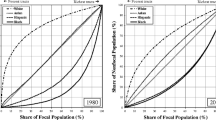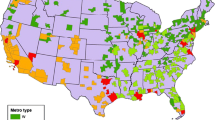Abstract
We extend research on whites’ neighborhood contact with blacks, population composition, and prospects for desegregation by developing a new measure of the floor of racial residential segregation under conditions of low black-white contact. The measure incorporates the way in which multi ethnic contexts further constrain levels of black-white segregation. The results show that black-white desegregation is likely when the black population is small, but is unlikely otherwise. Yet, when multiple ethnic groups are sufficiently large, a moderate level of black-white segregation is necessary for whites to maintain low neighborhood contact with blacks, even when the proportion of African Americans is small.
Similar content being viewed by others
References
Alba, R.D., N.A. Denton, S.J. Leung, and J.R. Logan. 1995. ” Neighborhood Change Under Conditions of Mass Immigration: The New York City Region, 1970-1990.”International Migration Review 29:625–56.
Alba, RD. and J.R Logan. 1993. “Minority Proximity to Whites in Suburbs: An Individual-Level Analysis of Segregation.”American Journal of Sociology 98:1388–427.
Bobo, L. and C.L. Zubrinsky. 1996. “Attitudes on Residential Integration: Perceived Status Differences, Mere In-Group Preference, or Racial Prejudice?”Social Forces 74:883–909.
Clark, WA.Y. 1991. “Residential Preferences and Neighborhood Racial Segregation: A Test of the Schelling Segregation Model.”Demography 28:1–19..
— 1992. “Residential Preferences and Residential Choices in a Multi-Ethnic Context.”Demography 29:451–66.
Davis, J.A. and T.W Smith. 1996.General Social Surveys, 19721996. [Machine-Readable Data File]. Chicago: NORC.
Denton, N.A. 1994. “Are African Americans Still Hypersegregated?” Pp. 49–81 inResidential Apartheid: The American Legacy, edited by R.D. Bullard, J.E. Grigsby III, and C. Lee. Los Angeles: CAAS Publicatiorts.
Denton, N.A. and D.S. Massey. 1991. “Patterns of Neighborhood Transition in a Multi-Ethnic World: U.S. Metropolitan Areas, 1970-1980.”Demography 28:41–63.
Duncan, O.D. and B. Duncan. 1955. “A Methodological Analysis of Segregation Indexes.”American Sociological Review 20:210–17.
Fannie Mae. 1992. “Discrimination in Housing and Mortgage Markets.” Housing Policy Debate 3(2).
Farley, R 1996. “Racial Differences in the Search for Housing: Do Whites and Blacks Use the Same Techniques to Find Housing?”Housing Policy Debate 7:367–85.
Farley, R. and WH. Frey. 1994. “Changes in the Segregation of Whites From Blacks During the 1980s: Small Steps Toward a More Integrated Society.”American Sociological Review 59:2345.
Farley, R., C. Steeh, T. Jackson, M. Krysan, and K. Reeves. 1993. “Continued Racial Residential Segregation in Detroit: Chocolate City, Vanilla Suburbs’ Revisited.”Journal of Housing Research 4:1–38.
Farley, R., C. Steeh, M. Krysan, T. Jackson, and K. Reeves. 1994. ” Stereotypes and Segregation: Neighborhoods in the Detroit Area.”American Journal of Sociology 100:750–80.
Frey, WH. and R. Farley. 1996. “Latino, Asian, and Black Segregation in U.S. Metropolitan Areas: Are Multiethnic Metros Different?”Demography 33:35–50.
Galster, G.C. 1986. “More Than Skin Deep: The Effect of Housing Discrimination on the Extent and Pattern of Racial Residential Segregation in the United States.” Pp. 119–38 inHousing Discrimination and Federal Policy, edited by J.M. Goering. Chapel Hill, NC: University of North Carolina Press.
— 1987. “The Ecology of Racial Discrimination in Housing: An Exploratory Model.”Urban Affairs Quarterly 23:84–107.
— 1992. “Research on Discrimination in Housing and Mortgage Markets: Assessment and Future Directions.”Housing Policy Debate 3:639–83.
Galster, G.C. and WM. Keeney. 1988. “Race, Residence, Discrimination, and Economic Opportunity: Modeling the Nexus of Urban Racial Phenomena.”Urban Affairs Quarterly 24:87–117.
Geolytics. 1996.Census CD. Distributed by Geolytics, Inc. New Brunswick, NJ.
Harrison, R.J. and D.H. Weinberg. 1992. “Changes in Racial and Ethnic Residential Segregation, 1980-1990.” Paper presented at the annual meeting of the American Statistical Association, Boston.
Jakubs, J.F. 1977. “Residential Segregation: The Taeuber Index Reconsidered.”Journal of Regional Science 17:281–83.
— 1979. “A Consistent Conceptual Definition of the Index of Dissimilarity.”Geographical Analysis 11:315–21.
— 1986. “Recent Racial Segregation in U.S. SMSAs.”Urban Geography 7:146–63.
James, D.R. and K.E. Taeuber. 1985. “Measures of Segregation.” Pp. 1–32 inSociological Methodology 1985, edited by N.B. Tuma. San Francisco: Jossey-Bass.
Logan, J.R. and R.D. Alba. 1993. “Locational Returns to Human Capital: Minority Access to Suburban Community Resources.”Demography 30:243–68.
Martin, P. and E. Midgley. 1994. “Immigration to the United States: Journey to an Uncertain Destination.”Population Bulletin 49(2):1–47.
Massey, D.S. and N.A. Denton. 1987. “Trends in the Residential Segregation of Blacks, Hispanics, and Asians: 1970-1980.”American Sociological Review 52:802–25.
— 1988. “The Dimensions of Residential Segregation.”Social Forces 67:281–315.
— 1989. “Hypersegregation in U.S. Metropolitan Areas: Black and Hispanic Segregation Along Five Dimensions.”Demography 26:373–91.
— 1993.American Apartheid: Segregation and the Making of the Underclass. Cambridge: Harvard University Press.
Massey, D.S. and A.B. Gross. 1991. “Explaining Trends in Racial Segregation, 1970-1980.”Urban Affairs Quarterly 27:13–35.
Nyden, P., M. Maly, and J. Lukehart. 1997. “The Emergence of Stable Racially and Ethnically Diverse Urban Communities: A Case Study of Nine U.S. Cities.”Housing Policy Debate 8:491534.
O’Connell, G.E. 1977. “Zelder’s Critique of the Index of Dissimilarity: A Misunderstanding of a Basic Assumption.”Journal of Regional Science 17:285–89.
O’Hare, W.P. 1992. “American’s Minorities-The Demographics of Diversity.”Population Bulletin 47(4):1–47.
Rosenbaum, E. 1992. “Race and Ethnicity in Housing: Turnover in New York City, 1978-1987.”Demography 29:467–86.
Schelling, T.C. 1971. “Dynamic Models of Segregation.”The Journal of Mathematical Sociology 1:143–86.
Schuman, H. and L. Bobo. 1988. “Survey-Based Experiments on White Racial Attitudes Towards Residential Integration.”American Journal of Sociology 94:273–99.
Schuman, H., C. Steeh, and L. Bobo. 1985.Racial Attitudes in America: Trends and Interpretations. Cambridge: Harvard University Press.
Steinnes, D.N. 1977. “Urban Employment and Residential Segregation: A Conditional Index.”Journal of Regional Science 17:291–98.
Taeuber, K.E. 1968. “The Effect of Income Redistribution on Racial Residential Segregation.”Urban Affairs Quarterly 4:5–14.
Taeuber, K.E. and A.F. Taeuber. 1965.Negroes in Cities: Residential Segregation. and Neighborhood Change. Chicago: Aidine.
Turner, M.A. 1992. “Discrimination in Urban Housing Markets: Lessons From Fair Housing Audits.”Housing Policy Debate 3: 185–215.
Turner, M.A., R.J. Struyk, and J. Yinger. 1991.Housing Discrimination Study: A Synthesis. of Police of Policy Development and Research, U.S. Department of Housing and Urban Development.
U.S. Bureau of the Census. 1982.1980 Census of Population and Housing, Summary Characteristics for Governmental Units and Standard Metropolitan Areas. Washington, DC: U.S. Government Printing of fice.
— 1992.1990 Census of Population, General Population Characteristics, Metropolitan Areas. Washington, DC: U.S. Government Printing of fice.
— 1993a.1990 Census of Housing, Detailed Housing Characteristics, Metropolitan Areas. Washington, DC: U.S. Government Printing of fice.
— 1993b.1990 Census of Population, Social and Economic Characteristics, Metropolitan Areas. Washington, DC: U.S. Government Printing of fice.
White, M.J. 1986. “Segregation and Diversity Measures in Population Distribution.”Population Index 52:198–221.
Yinger, J. 1995.Closed Doors, Opportunities Lost: The Continuing Costs of Housing Discrimination. New York: Russell Sage Foundation.
Zelder, R.E. 1970. “Residential Desegregation: Can Nothing Be Accomplished?”Urban Affairs Quarterly 5:265–77.
— 1972. “Racial Segregation: A Reply.”Journal of Regional Science 12:149–53.
— 1977. “On the Measurement of Residential Segregation: Reply.”Journal of Regional Science 17:299–303.
Zubrinsky, C.L. and L. Bobo. 1996. “Prismatic Metropolis: Race and Residential Segregation in the City of Angels.”Social Science Research 25:335–74.
Author information
Authors and Affiliations
Additional information
The order of authors is arbitrary and reflects equal coauthorship. We would like to thank Douglas S. Massey for his feedback and encouragement on an early draft of the ideas in this paper, and Roderick Harrison for making available a disk file with data on residential segregation for MSAs. The research reported in this paper was partially completed while both authors were on research leave at the Social Welfare Research Institute, Boston College. An early version of this paper was presented at the 1994 annual meeting of the Population Association of America in Miami.
Rights and permissions
About this article
Cite this article
Krivo, L.J., Kaufman, R.L. How low can it go? declining black-white segregation in A multiethnic context. Demography 36, 93–109 (1999). https://doi.org/10.2307/2648136
Issue Date:
DOI: https://doi.org/10.2307/2648136




